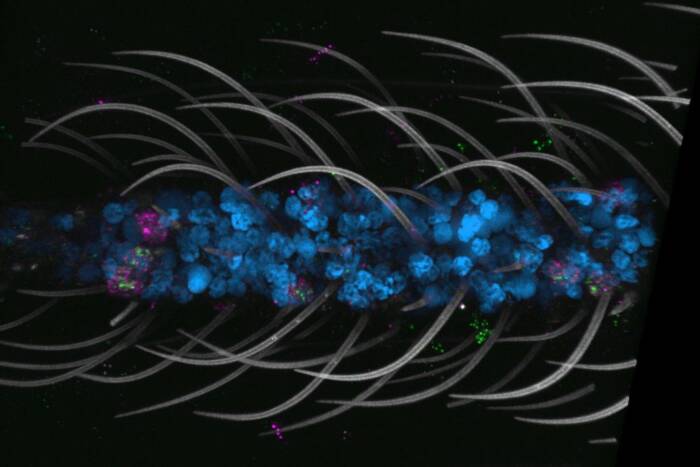 (opens in new window)Stricter ID checks. Guards manning the campus gates typically stop people they don’t recognize. But in order to better verify everyone who enters the campus, Security has been working with Development, Communications and Public Affairs and other offices to refine entrance procedures for guests. Identification cards have recently been issued, for example, to trustees and to attendees of the weekly Tri-Institutional Noon Recitals, and attendees of other public events will be required to show personal identification at the gate. “If someone with criminal intentions were to be watching our gates, we want them to see that we’re checking everyone,” says Mr. Rogers. (opens in new window)Stricter ID checks. Guards manning the campus gates typically stop people they don’t recognize. But in order to better verify everyone who enters the campus, Security has been working with Development, Communications and Public Affairs and other offices to refine entrance procedures for guests. Identification cards have recently been issued, for example, to trustees and to attendees of the weekly Tri-Institutional Noon Recitals, and attendees of other public events will be required to show personal identification at the gate. “If someone with criminal intentions were to be watching our gates, we want them to see that we’re checking everyone,” says Mr. Rogers.
 (opens in new window)New parking permits. The old parking stickers, which were affixed to vehicle windows, have been replaced with new hangtags that can be more easily seen by Security personnel. In addition, temporary parking permits are now issued to approved visitors who park temporarily on campus. Speed bumps have also been installed at the 64th and 66th Street gates to remind drivers to move slowly and to help ensure the safety of campus and neighborhood pedestrians. (opens in new window)New parking permits. The old parking stickers, which were affixed to vehicle windows, have been replaced with new hangtags that can be more easily seen by Security personnel. In addition, temporary parking permits are now issued to approved visitors who park temporarily on campus. Speed bumps have also been installed at the 64th and 66th Street gates to remind drivers to move slowly and to help ensure the safety of campus and neighborhood pedestrians.
 (opens in new window)Upgraded security cameras. Though the campus has had cameras in key locations for years, new surveillance equipment has been added in especially sensitive locations, and old cameras have been upgraded to digital, less-obstrusive dome-shaped models. Additionally, the perimeter closed-circuit television system, put in place by previous security director Joseph Nekola, has been migrated to a new platform that offers an easier user interface. (opens in new window)Upgraded security cameras. Though the campus has had cameras in key locations for years, new surveillance equipment has been added in especially sensitive locations, and old cameras have been upgraded to digital, less-obstrusive dome-shaped models. Additionally, the perimeter closed-circuit television system, put in place by previous security director Joseph Nekola, has been migrated to a new platform that offers an easier user interface.
 (opens in new window)Patrol verification. In the old days, Security personnel on their nightly rounds had to insert a special key located on each floor of each building into a portable time-keeping device in order to generate a record of their patrol (the “watch-clock” boxes containing the keys can still be seen in some buildings). That system, unused for many years, has now been replaced with one based on radio frequency ID chips like those used to deter shoplifting. Guards now scan small plastic discs, deployed across campus, with an electronic wand. The new technology, called a proxiguard tour system, provides supervisors with an electronic record of who patrolled each floor and when. (opens in new window)Patrol verification. In the old days, Security personnel on their nightly rounds had to insert a special key located on each floor of each building into a portable time-keeping device in order to generate a record of their patrol (the “watch-clock” boxes containing the keys can still be seen in some buildings). That system, unused for many years, has now been replaced with one based on radio frequency ID chips like those used to deter shoplifting. Guards now scan small plastic discs, deployed across campus, with an electronic wand. The new technology, called a proxiguard tour system, provides supervisors with an electronic record of who patrolled each floor and when.
 (opens in new window)Emergency response planning. With the help of the New York Fire Department, all 22 campus buildings have been relabeled at main entrances with addresses (1230 York Avenue is in fact an umbrella address used mainly for mail delivery) in order to provide easier access to municipal emergency personnel. On March 13, Security, Plant Operations and Lab Safety hosted FDNY officials in a mock incident response in Weiss Research Building, and provided them with information describing the locations of various hazardous substances used on campus. “The FDNY has legitimate concerns about the potentially volatile aspects of what we do here,” says Mr. Rogers. “But what was more troubling to them was simply not knowing how we operate, and the steps we’ve taken have clarified things for everyone.” (opens in new window)Emergency response planning. With the help of the New York Fire Department, all 22 campus buildings have been relabeled at main entrances with addresses (1230 York Avenue is in fact an umbrella address used mainly for mail delivery) in order to provide easier access to municipal emergency personnel. On March 13, Security, Plant Operations and Lab Safety hosted FDNY officials in a mock incident response in Weiss Research Building, and provided them with information describing the locations of various hazardous substances used on campus. “The FDNY has legitimate concerns about the potentially volatile aspects of what we do here,” says Mr. Rogers. “But what was more troubling to them was simply not knowing how we operate, and the steps we’ve taken have clarified things for everyone.”
 (opens in new window)Counter-terrorism training. As a result of requests by Security personnel, new training programs have been instituted in terrorism and ecoterrorism awareness, detecting hostile surveillance and other topics. Official protocols for situations including bomb threats, missing children and local or widespread blackouts have also been reappraised and codified. (opens in new window)Counter-terrorism training. As a result of requests by Security personnel, new training programs have been instituted in terrorism and ecoterrorism awareness, detecting hostile surveillance and other topics. Official protocols for situations including bomb threats, missing children and local or widespread blackouts have also been reappraised and codified.
|








